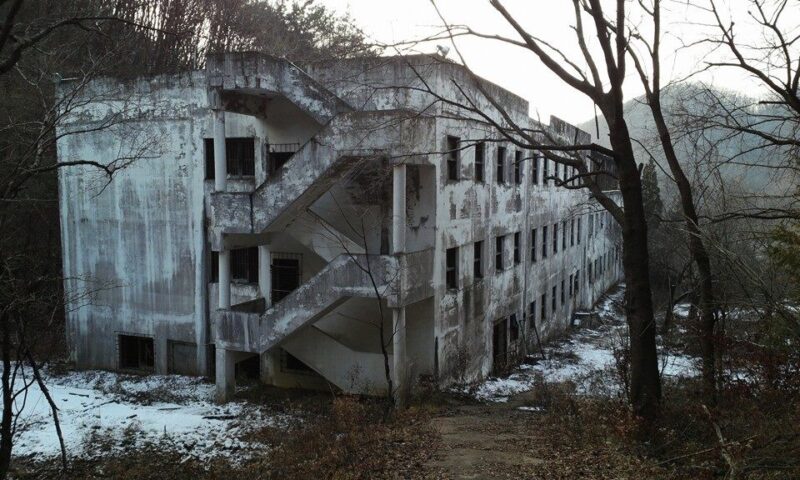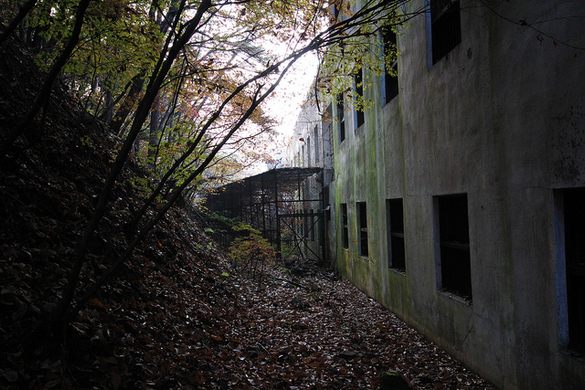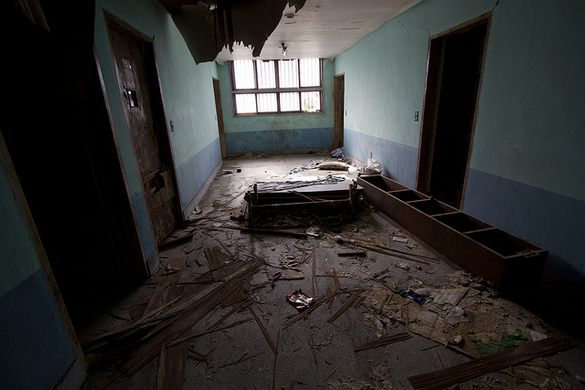Physical Address
304 North Cardinal St.
Dorchester Center, MA 02124
Physical Address
304 North Cardinal St.
Dorchester Center, MA 02124

Imagine stepping into a world of eerie silence, where the only sounds are your own heartbeat and the soft creaking of doors opening and closing, seemingly on their own. Where echoes of laughter and cries of despair from long-forgotten patients still reverberate through the decaying walls. Welcome to the world of Gonjiam Asylum, where reality and myth intertwine, leaving those who dare to venture into its dark halls questioning what is real and what is simply the effect of their own imagination running wild.
In this post, we will delve into the spine-chilling history of the infamous asylum, exploring the facts that surround this notorious location and the chilling urban legends that were born from the depths of its crumbling corridors. Buckle your seatbelts, because this journey will take you through the twisted minds of the tormented souls who once faced their darkest nightmares inside the walls of Gonjiam Asylum.
Gonjiam Asylum, located in South Korea, has garnered much attention and intrigue over the years due to its eerie atmosphere and chilling mysteries. Serving as the inspiration for the 2018 South Korean horror film, “Gonjiam: Haunted Asylum,” directed by Jung Bum-shik, the abandoned psychiatric hospital has become a popular destination for thrill-seekers and horror enthusiasts alike. The film centers around a group of six individuals who decide to live-stream their exploration of the supposedly haunted asylum, only to find themselves facing terrifying paranormal experiences. As the story unfolds, viewers are left on the edge of their seats, wondering what dark secrets lay hidden within the walls of the once-functioning psychiatric hospital.


However, the reality of the asylum’s history is just as murky as the fictional narrative. Rumors persist that the asylum’s director was a sadistic individual who tortured and killed his patients, before disappearing without a trace. Yet, there is little evidence to support such claims, leaving skeptics and believers alike in a state of uncertainty and curiosity. With its chilling background and eerie ambiance, Gonjiam Asylum remains a captivating mystery, capturing the imagination of those who dare to uncover its secrets.
The history of Gonjiam Asylum dates back to 1961 when it was built near Seoul in the city of Gwangju. Known for its expansive three-floor facility, the asylum housed patients who needed psychiatric care for various mental health issues. However, in 1996, the owner passed away, and due to local authority conflicts, his children opted not to take over the institution. As a result, the asylum was ultimately abandoned.
Over the years, the building began to deteriorate as no one took responsibility for its upkeep or restoration. Eventually, in 2018, the dilapidated structure was demolished, putting an end to the once-thriving mental health facility. Although numerous urban legends and myths grew around the abandoned asylum, most of these tales were unsubstantiated, with no police reports or family complaints to verify them. Furthermore, the patients from Gonjiam were successfully transferred to a hospital in Yongin after its closure. Despite the myths and rumors, the true story of Gonjiam Asylum is one of a neglected institution that fell into disrepair and became a historical building in South Korea.
Gonjiam Asylum, once situated in Gwangju-si, South Korea, was rumored to be one of the most haunted places in the country. Established in 1961, its sprawling three-floor facility was known to house patients with mental health issues. However, the asylum was abandoned in 1996 after the owner’s death and difficulties encountered by his children with local authorities. Over the years, the empty building began to deteriorate, which ultimately led to its demolition in 2018.
Countless myths surround Gonjiam Asylum, including tales about cruel treatment of patients, mysterious deaths, and mad doctors conducting experiments. Despite these claims, there is no documented evidence to support them. Although the asylum certainly had a grim past, it was primarily abandoned due to economic downturns, unsanitary conditions, and problems with the sewage disposal system. Debunking the paranormal stories didn’t prevent tourists, ghost hunters, and filmmakers from visiting the facility.
In fact, the 2018 horror film “Gonjiam: Haunted Asylum” further perpetuated the asylum’s eerie reputation. While the truth about Gonjiam Asylum may be less fantastical than fiction, its intriguing history continues to captivate the imagination of the public.
Many asylums around the world have had a dark past, particularly in the 20th century, when it comes to the treatment of patients. This led to numerous urban legends and stories about mysterious and horrifying incidents in such institutions. One of the main reasons for these legends is the inhumane treatments used on patients, such as lobotomy and electroconvulsive therapy. These methods were widely used in the past to “cure” mental illnesses, but they often caused irreversible damage and even death.
Adding to these gruesome techniques is the fact that asylums were generally closed off to the public, making it difficult for outsiders to know exactly what went on within their walls. This isolation provided ample opportunities for the abuse and neglect of patients to go unnoticed. Gone are the days when these cruel treatments were the norm; modern day psychiatric hospitals hold themselves to a much higher standard of care, focusing on utilizing humane and evidence-based therapies.
While urban legends about asylums like Gonjiam in South Korea continue to circulate, many of the stories are not based on factual data. Instead, these horrific tales often stem from the terrifying history and the nature of closed-off establishments where mentally ill individuals were subjected to inhumane treatment. Today, these stories serve as cautionary tales and reminders of the importance of prioritizing compassionate mental healthcare.
There are a number of myths associated with the infamous Gonjiam Asylum, an abandoned psychiatric hospital near Seoul, South Korea. Over the years, this eerie location has become the center of many urban legends and ghost stories. Many believe that the asylum witnessed cruel treatment of patients resulting in numerous unexplained deaths. Some say that the facility was run by mad doctors who conducted inhumane experiments on the patients, leading to even more deaths.
Other tales include stories of hospital employees being found dead under mysterious circumstances, followed by the suicide of the hospital director and the owner’s disappearance before its closure. However, it is important to note that there is no factual evidence supporting these claims. No official records of patient mistreatment, investigations into the deaths, or complaints about the asylum’s staff exist. In reality, the patients were transferred to another facility after it closed, and the owner passed away due to a chronic illness.
As for the purported ghosts and supernatural occurrences, these accounts are subjective and open to interpretation. The spooky atmosphere of the crumbling and abandoned asylum and the fascination with the unknown could be the contributing factors to these tales. While these myths may captivate the imagination and instill fear, they remain unverified and speculative in nature.
Despite the numerous legends and rumors surrounding Gonjiam Asylum, thorough investigations into the alleged mysterious deaths of patients and staff at the institution have revealed no concrete evidence to support such claims. First and foremost, there are no official reports filed by relatives or any other individuals at the local police station regarding mistreatment of patients at the asylum or mysterious deaths occurring on the premises.
Moreover, after the closure of the institution, all of Gonjiam’s patients were safely transferred to a hospital in Yongin, further debunking the myth that numerous patients had died under suspicious circumstances. As for the asylum’s director and owner, both faced ordinary circumstances that led to their departure from the institution: the owner passed away due to a chronic illness, and the director moved on to work elsewhere. Sadly, it seems the chilling tales associated with the asylum are fabricated, driven by people’s fascination with the eerie and unexplained.
Contrary to the popular myths surrounding the Gonjiam asylum, the reality of the director and owner’s lives were quite different. The owner of the hospital passed away due to a chronic illness, which contributed to the eventual closure of the institution. Instead of being involved in the mysterious and sinister events often associated with the asylum, the owner’s children simply did not wish to continue working in the hospital due to difficulties with local authorities.
As for the hospital’s director, rather than committing suicide as some stories would suggest, he actually went on to work in another location after the closure of Gonjiam. There were no formal complaints or concerns about his work while he was at Gonjiam, and the rumors of cruel treatment and unexplained deaths have not been substantiated. In fact, following the closure of the asylum, all the patients from Gonjiam were transferred to a hospital in Yongin, where they continued to receive care. While urban legends and horror stories may attract attention, it is important to remember that the truth about the director and owner of Gonjiam Hospital lies in the real, tangible facts.
The existence of ghosts at the infamous Gonjiam Asylum has long been a topic of debate and intrigue among paranormal enthusiasts and skeptics alike. Over the years, numerous urban legends and spooky stories have emerged, claiming that the abandoned asylum is teeming with supernatural activity, predominantly the spirits of former patients and staff who tragically lost their lives within its walls.
However, a closer examination of the surrounding myths and stories reveals a distinct lack of concrete evidence to support these claims. The absence of any official police reports or complaints regarding the mistreatment of patients, as well as the fact that all former Gonjiam patients were successfully transferred to another facility following the asylum’s closure, raises doubt as to whether there is any truth behind these eerie tales.
Moreover, the owner of the asylum is known to have passed away from a chronic illness, and the hospital director simply moved on to another job, further challenging the notion that some dark, supernatural force was at work within the abandoned building.
In conclusion, the controversy surrounding the existence of ghosts at Gonjiam Asylum appears to have more to do with the human fixation on the unknown and a desire to unearth mysterious phenomena than any conclusive, factual evidence. As such, the debate over the supposed paranormal activity at Gonjiam Asylum will likely continue to captivate the imaginations of believers and skeptics alike for years to come.
The Gonjiam Psychiatric Hospital in Gwangju-si, South Korea, has been the center of public interest and hype for many years. Positioned as one of the most haunted places in the country, its reputation has been further fueled by the 2018 horror film, Gonjiam: Haunted Asylum. The film brought the dark and mysterious halls of the abandoned hospital to the attention of both local and international audiences, increasing the intrigue surrounding its history. However, contrary to popular belief, the real story behind the hospital’s closure isn’t rooted in supernatural occurrences. Economic challenges, problems with the sewage disposal system, and unsanitary conditions are the actual reasons for its abandonment.
Despite being closed to the public, approximately a thousand curious visitors trespass onto the property annually, in hopes of capturing evidence of paranormal activity. The Gonjiam Psychiatric Hospital has become a ghost-hunting hotspot with its decrepit state and eerie atmosphere, attracting camera crews, and paranormal investigators. Though the hospital was demolished in May 2018, the allure of its haunting past continues to pique public interest.